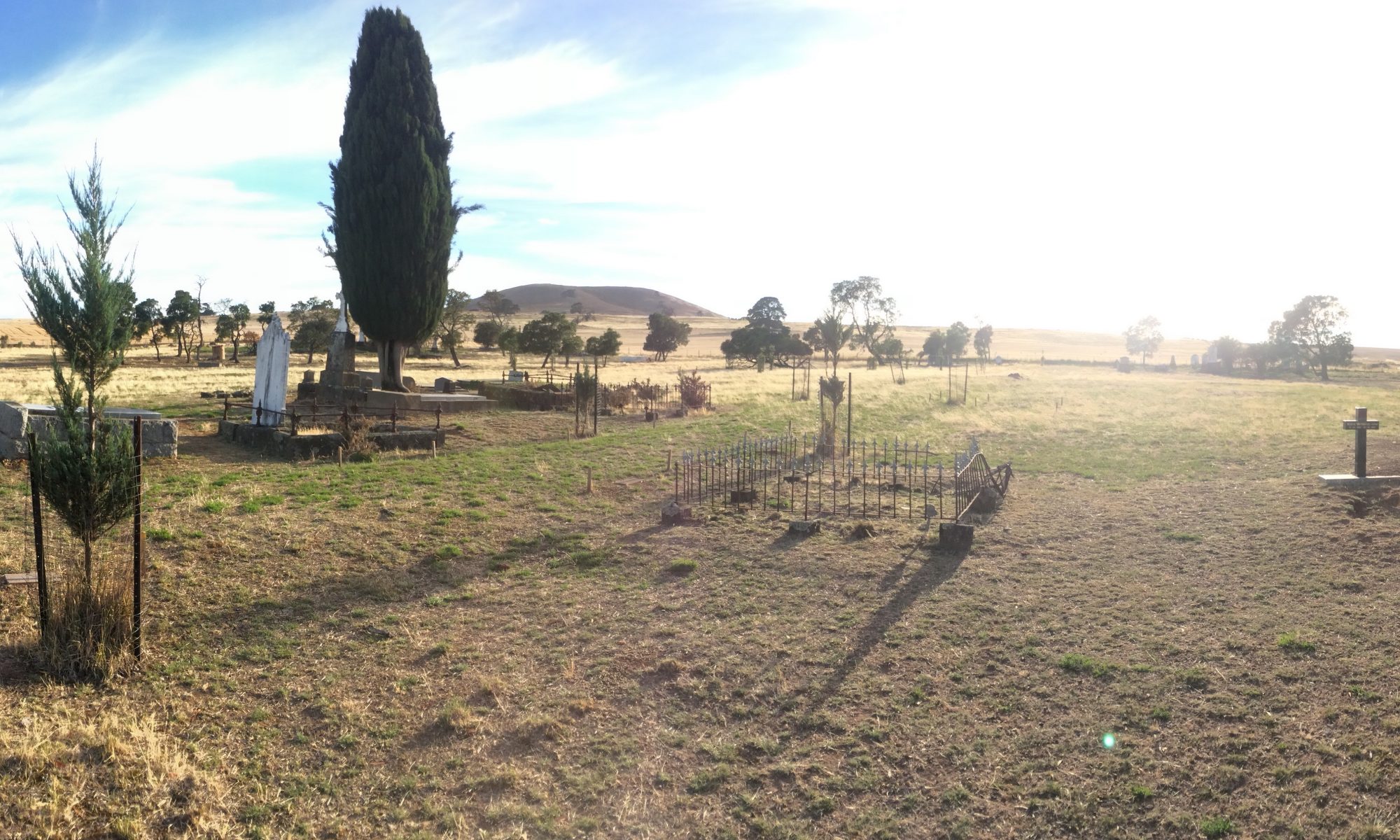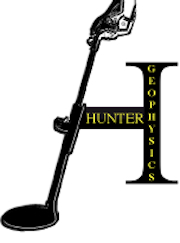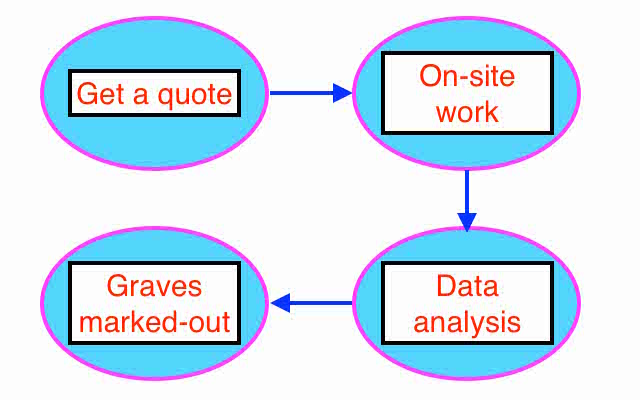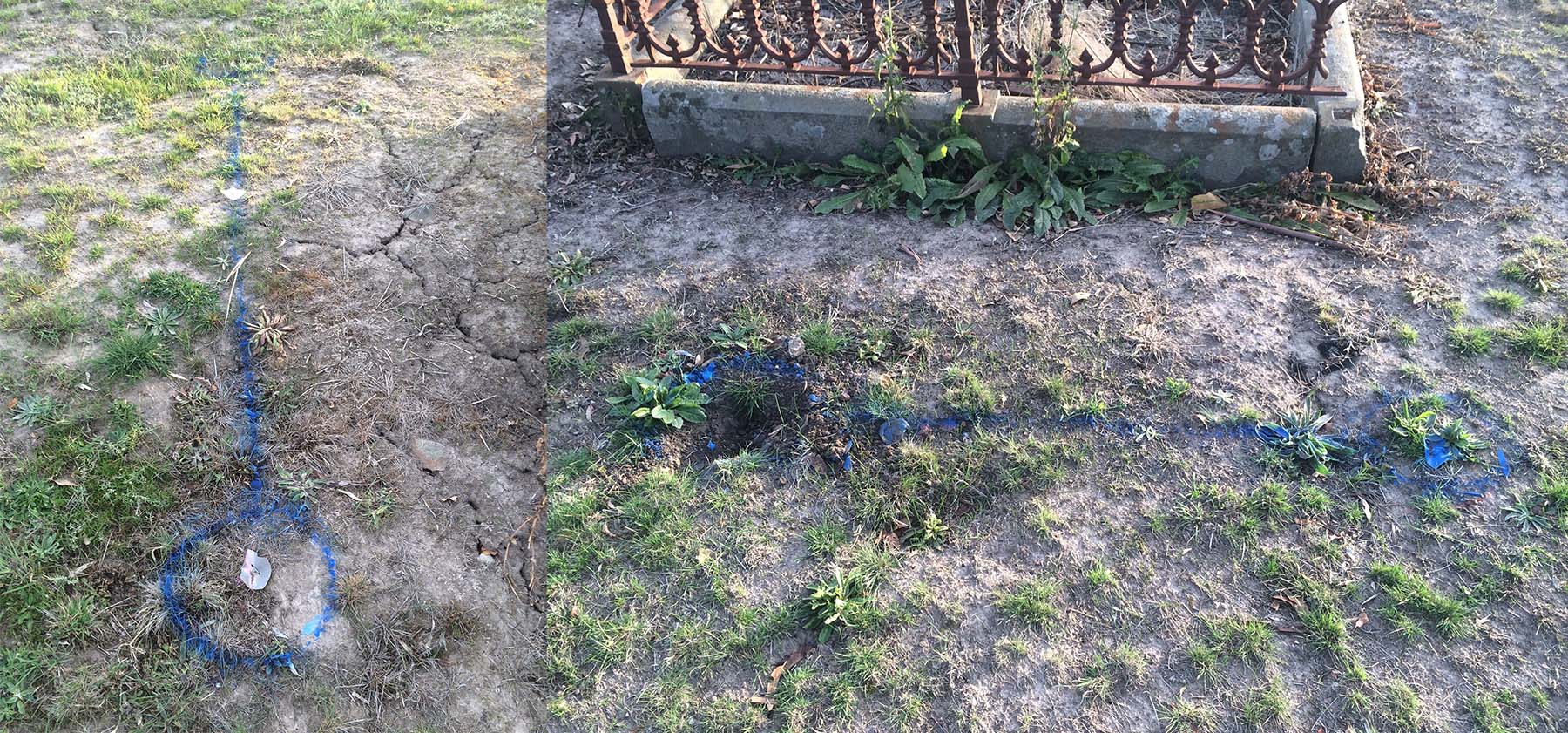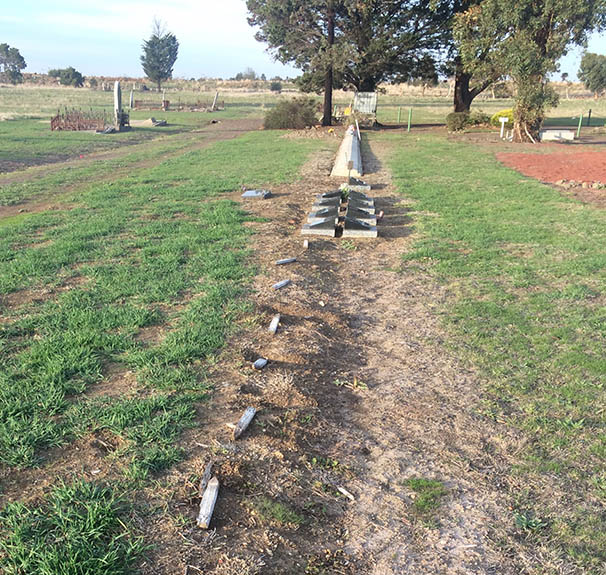
Using various geophysical methods, Hunter Geophysics is capable of remotely detecting lost or unmarked graves. Most of the time, we perform searches using ground-penetrating radar.
Our services are used in cemeteries to prevent old, forgotten graves from being accidentally exhumed when new graves are being dug.
The process
- Call Dave the grave Hunter for a quote on 0488 501 261 (or you may email him if you would like). Please have the following information ready:
- How large is the area you want searched (please provide the length and width of the area, in metres).
- What is on the ground surface? e.g. long grass, lawn grass, concrete, gravel, is it a road surface, etc.
- Are there any trees or plants within the search area?
- Are there any headstones or any other obstacle within the search area?
- Please email David photographs of the area, clearly showing the location of any obstacles in the area you would like searched.
- Note: Dave may recommend that we conduct a “site assessment” instead – this involves us visiting the cemetery and meeting with you to discuss what areas need to be searched, and we would create a map and take photographs while we’re there to allow us to plan correctly and produce an accurate quote. For cemeteries in Victoria, the cost of a site assessment can be covered by a Department of Health grant; we will walk you through this process if this is necessary (that is, we will give you a mostly-complete grant application form that you just need to sign and send to the Department of Health).
- Once the above information has been provided (or a site assessment has been done), Dave will provide you with a written quotation. If you are in Victoria, you may then apply for funding for the project from the Department of Health (we will even fill in the grant application form for you if you wish).
- Once the project is approved by the client, we obtain all necessary permits (this is particularly relevant for Victorian cemeteries), and then Dave will book in a date that suits the cemetery for the search to be performed.
- The cemetery trust will need to prepare the search area so that it is suitable for the equipment we use. This usually entails mowing the grass and removing any rubbish from the area; more details about this can be found on the last two pages of this template cemetery quote.
- The on-site work is performed. We can search an area of dimensions up to 50 metres by 50 metres in a day, assuming there are no obstacles. Obstacles such as trees, shrubs, and headstones will slow down the search speed.
- After the on-site work is done, we return to our office in Melbourne and examine all the data we collected, and write up a report detailing our findings. This process can take several weeks to several months, depending on the size of the search area. You can read some example reports we’ve written for past clients here.
- After we deliver our final report to you, we can provide you with a quotation to actually mark-out the graves on the ground. The graves are marked out with spray paint and vinyl flooring. This temporary measure allows the cemetery to create permanent markers for the graves (most cemeteries opt to place concrete blocks on the graves).
- For cemeteries in Victoria, we are required under Section 131 and Section 132 of the Heritage Act 1995 to research the history of the cemetery and report our findings to Heritage Victoria. These rules apply to anyone searching for unmarked graves anywhere in Victoria (although we are aware that many of our competitors do not do this). This report is due for submission to Heritage Victoria within twelve months from the completion of all on-site work, and is done in the months after the survey itself. This report is not usually provided to the client, but will be made available upon request at no extra cost.
It is important to note that we do not mark-out the location of unmarked graves until step 7 in the above list.
You can read some example reports we’ve written for past clients here.
Please call Dave the grave Hunter for a quote on 0488 501 261 (or you may email him if you prefer).
Some frequently asked questions:
- “How does the technology work?”
Ground-penetrating radar (GPR) maps any disturbances in the natural layering in the ground. For example, if a hole has been dug for a burial, that will have disturbed the natural layering of the soil, and this disturbance can be detected. This is how we find unmarked graves.
The GPR is mounted on a cart that we push around by hand. It makes no noise and does no damage to the ground surface at all. GPR signals are very narrow, so we can only find out what is buried underneath where we push the GPR. This means that to cover a large area, we have to walk up and back many times until we completely cover the area. To do this, we cover the search area with perfectly-straight, perfectly-parallel string lines that are 25cm apart. We then push the GPR along those string lines to ensure we achieve complete coverage of the area.
More details on the science behind GPR can be found here.
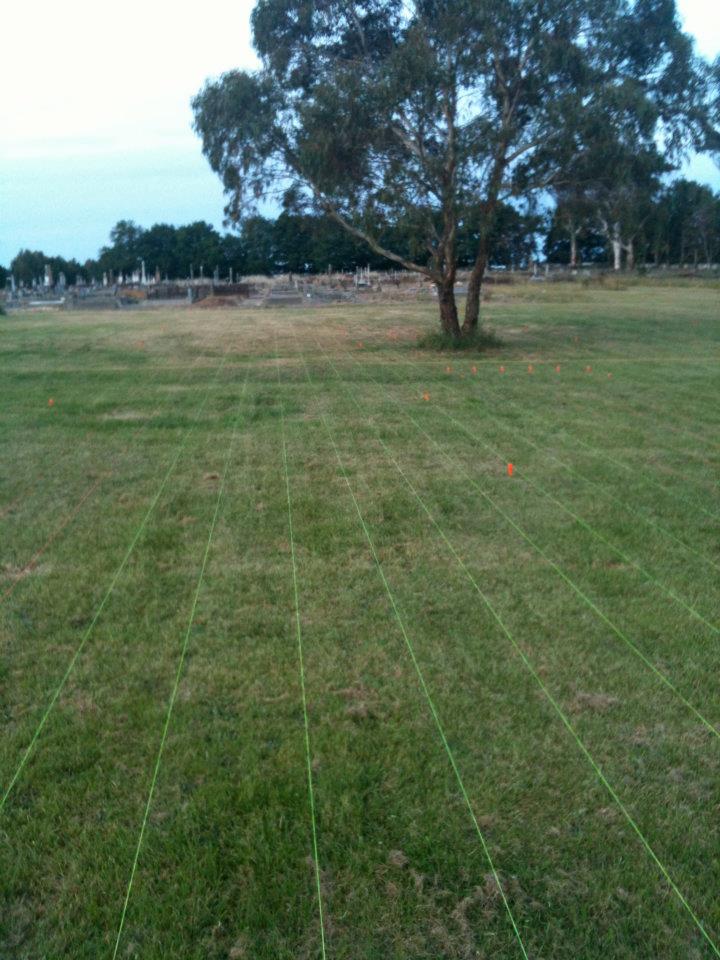
- “What does it cost?”
Ultimately, this comes down to how large is the area you need searched for unmarked graves, and how many obstacles there are in the area.
Generally, we can search a single area of dimensions not exceeding 50m x 50m in a day, assuming it does not have any obstacles in it, and is mowed so the grass is short. We can also cover several smaller areas in a day, depending on their sizes. However, the areas must be rectangular, and must not have any obstacles in them (otherwise, we can’t keep our string-lines straight).
If you need us to search an area that has a few headstones or trees in it, we can prepare several smaller rectangle areas around the obstacles. Setting up each rectangular area takes time, and so the actual area covered in a day will be less (in comparison to searching one large area with no obstacles).
If you can provide us with the dimensions of the areas to be searched (without any obstacles in them), then we can quickly calculate how long it will take and – therefore – the price. If you can’t provide these dimensions, though, we can visit the cemetery and perform an on-site assessment. The on-site assessment involves using survey equipment to map the areas you need searched, along with any obstacles that may be in the area. We can then draw rectangular areas on the map and determine the price for the search. An on-site assessment costs roughly $600-$900 for cemeteries within Victoria, depending on how far away the cemetery is from Melbourne (e.g. a cemetery in Mildura will necessitate two nights in a motel, and will cost more than a cemetery within Melbourne). On-site assessments outside of Victoria are usually too expensive (in which case, we will direct you how to provide the information we need via e.g. email or phone call).
How we determine the price of a search for unmarked graves is as follows: for the first day we are on-site, we charge $6,200, including GST; for any additional days of on-site work, we charge $2,970, including GST. For cemeteries within Victoria, we charge an additional $1,300 including GST to cover the costs of the mandatory Heritage Victoria reporting (explained above). For cemeteries outside of Victoria, we may also charge an additional fee to cover our travel and accommodation costs. There may be additional costs incurred where there is no Telstra mobile phone or GPS corrections network coverage at the cemetery (as this requires us to bring additional equipment), but this is very rare (it has happened only once in the ten years we have been in business).
These figures are fully-inclusive. We don’t charge anything in addition to what is written above in order to conduct a search for unmarked graves. All the costs of preparing for the search, conducting the search, and all the report-writing work required, is included in these figures. (We do, though, charge an additional fee to mark out the graves that we find on the ground, but this is under a separate contract).
An example – for a cemetery within Victoria, with a 50m x 50m area and a 20m x 30m area: this would take two days of on-site work and would cost a total of $9,700 (Day 1 $5700 + Day 2 $2800 + Heritage Victoria reporting costs $1200).
The above pricing is as of April 2020; pricing may vary in future and this webpage might not be up-to-date when you view it.
- “Will the Department of Health really fund grant applications that are that costly?”
In short, yes. The Department of Health have funded the majority of our searches for unmarked graves, with projects varying in price from $6,500 to $29,000. We generally advise keeping the grant application to around $15,000, though, to minimise the risk of not receiving funding (as the available funds are competed for by all cemeteries that apply). Cemeteries are able to apply for further funding (e.g. to search other areas within the cemetery) at a later date – it is not necessary to search an entire cemetery within the one grant application. Sometimes, the Department of Health will only provide partial funding for a project. In such cases, we can simply reduce the number of days we work on-site to fit into whatever funds are actually provided by the Department of Health, and then do the remaining work under another grant application in the following round of grants.
- “Can we scan in between headstones?”
Yes. We have developed a technique that allows us to search individual burial plots and check for unmarked graves. This technique is relatively new (we developed it and first started using it in cemeteries in 2014) but has been successful where applied.
- “Can you see how many bodies are buried within one burial plot?”
GPR does not (usually) directly detect bodies. Instead, it is detecting the area of soil disturbance. We note that the soil may be disturbed in an area of roughly 7ft x 3ft, extending from the ground surface to a metre or more deep, and then assume that the disturbance was caused by digging a grave. It is not normally possible to see individual bodies or coffins within burial plots.
- “Can you scan flat headstones and see how many people have been buried under them?”
We’re working on developing this capability, but as of mid-2019 (at the time of writing), this is not yet possible.
- “I work for a very small cemetery in the middle of nowhere in Victoria. Am I unlikely to get government funding?”
The grants are competitive and the funding available is limited, meaning that if another cemetery has a more urgent requirement (e.g. if they need funding to repair a building that looks like it may collapse soon), then they will be given priority. However, almost all of the cemeteries we have worked for in the past have been very small and very remote, and all received government funding. What is important is that cemetery trusts recognise that their first, second, third, etc. grant applications may be rejected, but their fourth grant application may be approved simply because the timing was right (e.g. there might not have been as many cemeteries applying for funding at that time). Persistence is key.
The Department of Health and Human Services specifically taxes A-Grade (larger) cemeteries in Victoria to fund grants for smaller (B-Grade) cemeteries. The grants are specifically intended for small cemeteries! In fact, we’ve never worked at a larger cemetery in Victoria: all of our surveys have been in small cemeteries.
- “The Department of Health website says we can’t apply for funding for another year or so”.
That’s true; they do say that on their forms. In reality, though, if the Department of Health don’t receive many funding requests from cemeteries, they will consider providing funding to cemeteries who have already received funding recently. Many of our clients today have received grants three or four funding rounds in a row (there are two funding rounds per year) simply because there weren’t many other cemeteries requesting funding.
We were recently (early 2019) advised that there is $3 million available each funding round, and only $1 million is ever applied for by cemeteries. There is plenty of money available for cemeteries to apply for.
Cemetery trusts have nothing to lose by submitting a grant application. We do the paperwork for you – all you need to do is get Trustees to sign the form and then post it to the Department of Health.
- “Your competitor says you don’t need to have the string lines 25cm apart, you can halve the workload (and cost) by having them 50cm apart instead.”
Putting it bluntly, they’re wrong and they’re cutting corners. Here are two maps based on GPR data we collected from a cemetery near Ballarat in 2015 – one collected at 25cm line spacing, the other at 50cm line spacing:

The first map shows a number of red or yellow blobs. These are mostly unmarked graves (the smallest yellow blobs are probably infant burials). This map was created using GPR data taken along lines 25cm apart (which is our standard practice).
The second map was created by deleting every second line in the computer software (which mimics the effect of collecting GPR data along lines that are 50cm apart). You can clearly see there is a lot of detail missing from the 50cm-line-spacing map. This means that many unmarked graves could be completely missed. This is why we use a 25cm line spacing. Using a 50cm line spacing for detecting unmarked graves is – in our opinion – negligent.
- “Can’t we just use a grader/excavator and look for changes in soil colours or textures?”
- Different soils will behave differently over time (and, therefore, may not have a noticeably-different soil colour or texture where a grave may be. You may completely miss a grave using this method.
- An excavator or a grader will rejuvenate the top-soil and will encourage the growth of undesirable weeds, and will also destroy whatever lawn was there prior to excavation.
- An excavator can’t cover the large areas that GPR can, and it costs more.
- An excavator can’t reach in tight spaces such as in-between headstones, whereas GPR can.
- Enjoy doing all the paperwork involved with exhuming someone. GPR avoids this altogether.
- “Can’t we just use a metal probe to see if we can tap on the coffin lid?”
- You’d have to have a fairly long metal probe (about 2m).
- Good luck getting that into compacted soil (clays and silts) or gravel soils.
- Good luck getting it out of the soil when you’re done.
- You’re going to be sticking that thing in the ground thousands of times in order to cover a search area. Even doing it once will be a massive undertaking.
- The assumption that the coffin lid will still be intact (after potentially hundreds of years) is usually wrong.
- You may unknowingly hit a buried rock instead of a coffin lid. You would have no way of knowing if what you hit was a grave or a rock.
- “Do you have any examples of survey reports you have produced for other cemeteries?”
Yes; we have made a number of our past reports available (with cemetery-identifying details redacted to protect our client’s privacy) here.
